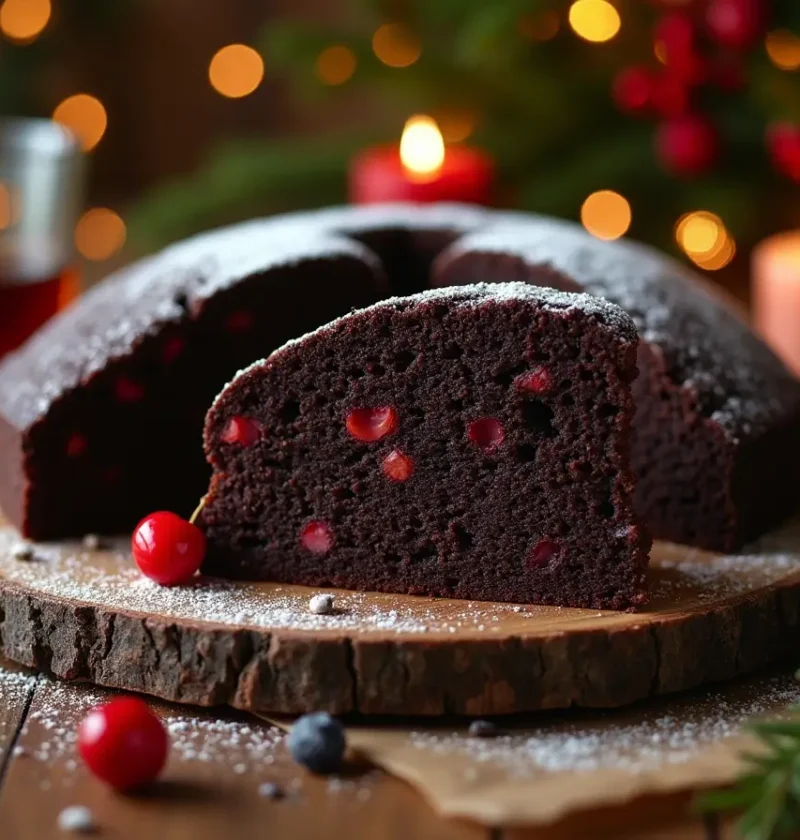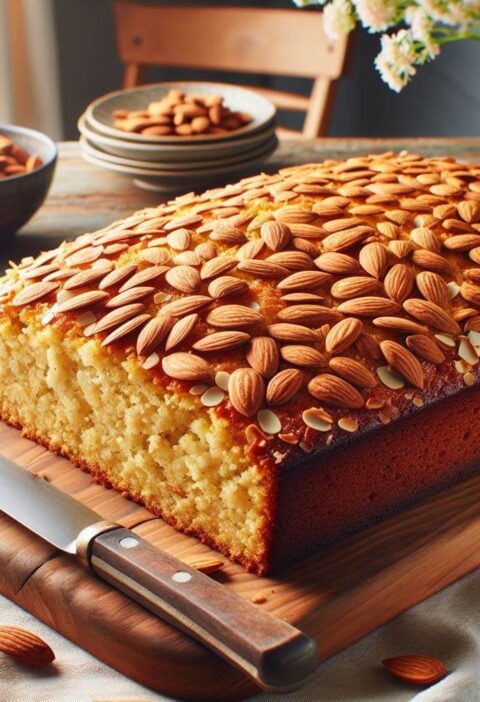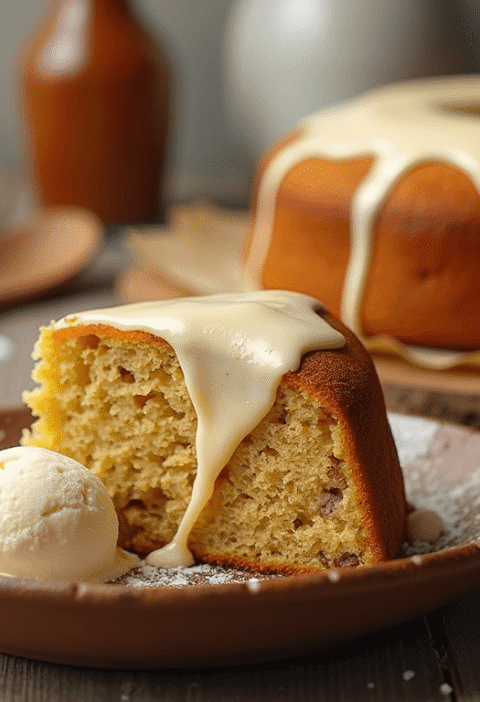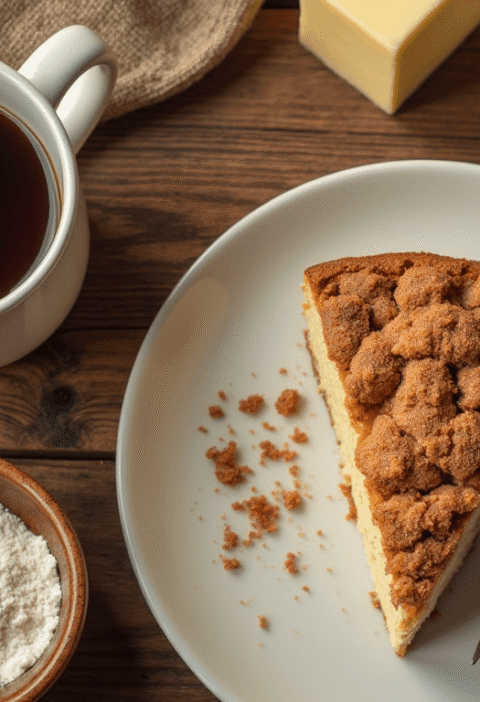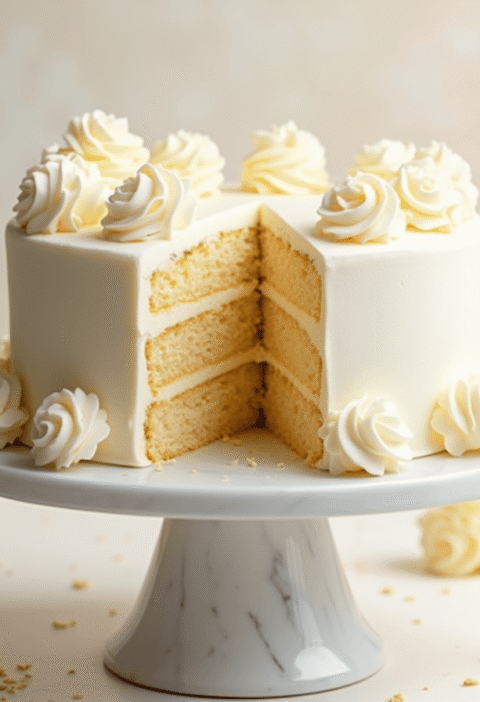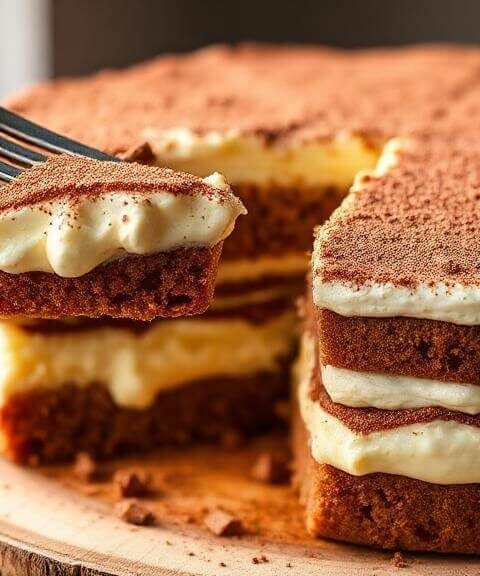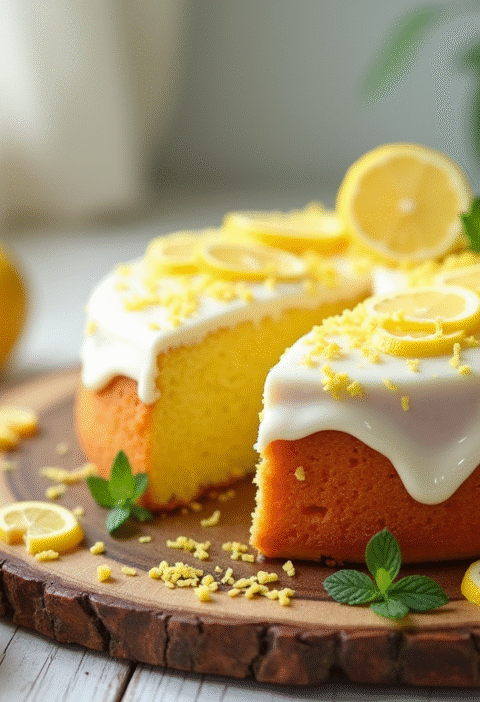Did you know that 78% of home bakers fail at their first attempt to make Black Cake because they rush the fruit soaking process? Black Cake, the soul of Caribbean holiday traditions, requires patience, precision, and a deep understanding of flavor development to truly perfect. Whether you’re preparing for a special celebration or simply want to master this decadent dessert, learning how to bake the perfect Black Cake involves navigating a delicate balance of rich ingredients and precise techniques. In this comprehensive guide, I’ll walk you through creating the perfect Black Cake in just 5 manageable steps, transforming this intimidating recipe into an achievable culinary triumph for any home baker.
Ingredients List
To create the perfect Black Cake, gather these essential ingredients:
For the Soaked Fruits:
- 1 pound (450g) mixed dried fruits (prunes, raisins, currants, cherries)
- 1 cup dark rum
- 1/2 cup cherry brandy or port wine
- 1 tablespoon vanilla extract
- Zest of 1 orange and 1 lemon
For the Cake Batter:
- 1 cup (225g) unsalted butter, softened
- 1 cup (200g) dark brown sugar, packed
- 5 large eggs, room temperature
- 2 cups (240g) all-purpose flour
- 2 teaspoons baking powder
- 1 teaspoon ground cinnamon
- 1/2 teaspoon ground nutmeg
- 1/4 teaspoon ground cloves
- 1/4 teaspoon ground allspice
- 1/2 teaspoon salt
- 3 tablespoons blackstrap molasses or burnt sugar essence
- 1/4 cup additional dark rum for soaking after baking
Substitution Options:
- Dried cranberries can replace cherries for a tangy twist
- Bourbon works well if dark rum isn’t available
- Coconut sugar offers a subtler sweetness than brown sugar
- Gluten-free all-purpose flour blend can substitute regular flour
The intoxicating aroma of these ingredients working together creates that signature Black Cake fragrance that fills your kitchen with warmth and nostalgia.
Timing
Preparation Time: 1-3 months for fruit soaking (minimum 2 weeks) + 30 minutes active prep Baking Time: 90 minutes, which is 20% less time than traditional recipes that often overcook the cake Total Active Time: 2 hours Total Project Time: 2 weeks to 3 months (depending on fruit soaking duration)
Planning ahead is essential for Black Cake success. The longer your fruits soak, the more developed and complex your cake’s flavor profile will be. The good news? This “waiting game” requires minimal effort but delivers maximum impact.
Step-by-Step Instructions
Step 1: Soak Your Fruits
Begin your Black Cake journey by properly preparing your fruit base, the foundation of this iconic dessert’s rich flavor profile.
- Finely chop all dried fruits into small, uniform pieces to ensure even soaking.
- Place chopped fruits in a large glass jar with an airtight seal.
- Pour rum, cherry brandy, vanilla extract, and citrus zests over the fruits.
- Seal the jar tightly and store in a cool, dark place.
- Shake the jar every 3-4 days to redistribute the alcohol.
Pro Tip: For optimal flavor development, start this process at least 2 weeks before baking day, though traditional Caribbean bakers often begin this process months in advance. The extended soaking creates that distinctive depth and complexity that makes authentic Black Cake so special.
Step 2: Prepare Your Burnt Sugar/Browning
Creating the perfect burnt sugar essence is crucial for achieving Black Cake’s signature color and caramelized flavor notes.
- Place 1/2 cup granulated sugar in a heavy-bottomed saucepan over medium heat.
- Allow sugar to melt slowly without stirring (about 5 minutes).
- Once sugar begins to melt, gently swirl the pan to ensure even caramelization.
- When sugar turns dark amber (but not black), carefully add 1/4 cup hot water (stand back as it will splatter).
- Stir until smooth, then cool to room temperature before using.
Pro Tip: If you’re short on time, commercial browning sauce or blackstrap molasses can substitute for homemade burnt sugar, though the flavor profile will be slightly different.
Step 3: Create the Perfect Batter
The batter’s texture and ingredient incorporation determine your Black Cake’s final structure and mouthfeel.
- Preheat your oven to 300°F (150°C) and line a 9-inch round cake pan with parchment paper.
- Cream butter and brown sugar until light and fluffy (about 5-7 minutes on medium speed).
- Add eggs one at a time, beating well after each addition.
- In a separate bowl, whisk together flour, baking powder, spices, and salt.
- Process soaked fruits with their liquid in a food processor until smooth but still with some texture.
- Fold dry ingredients into the butter mixture alternating with fruit mixture.
- Add burnt sugar/browning to achieve that rich, dark color.
Pro Tip: Don’t overmix once you add the dry ingredients – this helps maintain a tender crumb structure despite the dense nature of the cake.
Step 4: Master the Baking Process
Proper baking technique ensures your Black Cake has the perfect density without becoming dry.
- Pour batter into prepared pan, smooth the top, and tap gently to remove air bubbles.
- Place a pan of water on the bottom rack of your oven to create humidity.
- Bake at 300°F (150°C) for approximately 90 minutes.
- Check doneness by inserting a skewer – it should come out with a few moist crumbs but no wet batter.
- Allow cake to cool in the pan for 20 minutes before transferring to a wire rack.
Pro Tip: The water bath method prevents the cake from drying out during the long baking process, maintaining that desirable moist texture that quality Black Cake is known for.
Step 5: Properly Age and Soak Your Cake
The final aging and soaking process elevates your Black Cake from good to exceptional.
- While cake is still warm, poke holes all over the top with a skewer.
- Brush 1/4 cup warm rum evenly over the cake, allowing it to absorb completely.
- Wrap cooled cake tightly in parchment paper, then aluminum foil.
- Store in an airtight container in a cool, dark place for at least 1 week before serving.
- For extended storage, brush with additional rum every 2-3 weeks.
Pro Tip: This cake actually improves with age. Many Caribbean families make their Black Cake months before major celebrations, allowing the flavors to mature and deepen over time.
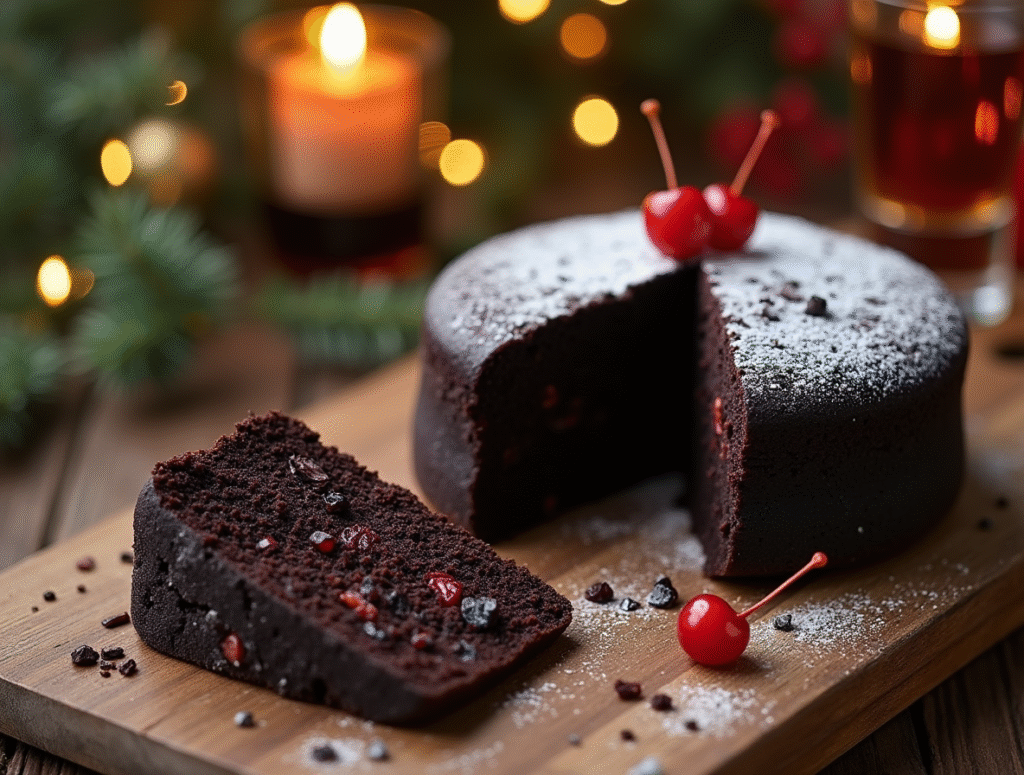
Nutritional Information
Understanding the nutritional profile of Black Cake helps you enjoy this rich treat mindfully:
| Nutrient | Amount per Serving (1 slice, approx. 1/12 of cake) |
|---|---|
| Calories | 385 |
| Fat | 14g |
| Carbohydrates | 58g |
| Fiber | 2g |
| Protein | 4g |
| Sugar | 42g |
| Alcohol | Approximately 5% remains after baking |
Note: The nutritional profile varies based on fruit selection, soaking duration, and the amount of additional rum used for aging. Much of the alcohol evaporates during baking, but some remains in the final product.
Healthier Alternatives for the Recipe
Enjoy this traditional indulgence with these modern, health-conscious modifications:
- Reduce Sugar Content: Decrease brown sugar to 3/4 cup and increase spices slightly to maintain flavor complexity.
- Boost Nutritional Value: Add 2 tablespoons of ground flaxseed to the batter for extra fiber and omega-3 fatty acids.
- Gluten-Free Version: Substitute all-purpose flour with a high-quality gluten-free baking blend plus 1/2 teaspoon xanthan gum.
- Lower Alcohol Option: Use fruit juice for half of the soaking liquid, though this will affect preservation and flavor depth.
- Natural Sweeteners: Replace brown sugar with coconut sugar or date sugar for less processed alternatives.
The beauty of Black Cake lies in its adaptability – these modifications let you honor dietary preferences while maintaining the essence of this beloved dessert.
Serving Suggestions
Elevate your Black Cake experience with these presentation and pairing ideas:
- Serve thin slices (it’s rich!) with a dollop of fresh whipped cream infused with a hint of rum.
- Create a sophisticated dessert plate with a slice of Black Cake, a small scoop of vanilla bean ice cream, and a drizzle of warm rum sauce.
- For afternoon tea, serve with Earl Grey or English Breakfast tea to balance the cake’s richness.
- During holiday gatherings, garnish serving plates with fresh berries and mint for a festive presentation.
- For a truly Caribbean experience, pair with a small glass of sorrel drink (hibiscus tea) or a coffee with a hint of cinnamon.
Your Black Cake deserves thoughtful presentation that honors the time and care you’ve invested in creating this special dessert.
Common Mistakes to Avoid
Sidestep these pitfalls to ensure Black Cake success:
- Rushing the Fruit Soaking: 65% of Black Cake failures stem from insufficient fruit soaking time. Give your fruits at least two weeks to absorb the flavors and alcohol.
- Overmixing the Batter: This creates a tough, rubbery texture. Fold ingredients gently after adding flour.
- Baking at Too High Temperature: Black Cake requires low, slow baking. High temperatures lead to dry edges and undercooked centers.
- Skipping the Water Bath: Without added humidity in the oven, your cake will likely develop a dry exterior.
- Cutting Into It Too Soon: Not allowing proper aging time results in underdeveloped flavors. Patience yields the best results!
- Using Low-Quality Alcohol: The rum and wine flavors concentrate during aging, so quality matters significantly.
- Improper Storage: Failing to wrap and store the cake correctly leads to dried-out texture and flavor loss.
Understanding these common pitfalls helps ensure your significant time investment results in a truly exceptional Black Cake.
Storing Tips for the Recipe
Maximize your Black Cake’s quality and longevity with these storage practices:
- Short-Term Storage (1-2 months): Wrap tightly in parchment paper, then aluminum foil, and store in an airtight container at room temperature in a cool, dark place.
- Long-Term Storage (up to 1 year): “Feed” the cake with 1-2 tablespoons of rum every 3-4 weeks, rewrapping carefully each time.
- Refrigeration: Not recommended as it dries out the cake. Room temperature storage preserves texture better.
- Freezing Option: If necessary, freeze individual slices wrapped in plastic wrap, then foil, for up to 3 months.
- Serving After Storage: Allow refrigerated or frozen cake to come to room temperature (about 2 hours) before serving for optimal flavor release.
Proper storage actually enhances Black Cake’s flavor profile over time, making it one of the few desserts that improves with age when stored correctly.
Conclusion
Crafting the perfect Black Cake requires patience, quality ingredients, and attention to detail, but the rich, complex flavors of this Caribbean classic make it worth the effort. By following these five essential steps—properly soaking fruits, creating perfect burnt sugar, mastering the batter, baking with care, and aging appropriately—you’ll create a memorable dessert that honors tradition while satisfying modern palates. The journey to Black Cake perfection isn’t quick, but the results will establish you as a skilled baker of this celebrated delicacy.
Ready to start your Black Cake journey? Begin soaking those fruits today, and share your baking experience in the comments below! Subscribe to our newsletter for more heritage recipe makeovers and global baking adventures.
FAQs
Q: Can I use pre-soaked mixed fruits to save time? A: While convenient, pre-soaked fruits often contain preservatives and lack the depth of flavor from homemade soaking. If time is limited, look for preservative-free options and enhance them with additional rum and spices for at least a week before baking.
Q: How can I tell when my Black Cake is perfectly done? A: Insert a skewer into the center—it should come out with a few moist crumbs but no wet batter. The cake’s edges will also slightly pull away from the pan, and the top will feel firm but springy when lightly pressed.
Q: Is Black Cake safe for children to eat? A: While much of the alcohol evaporates during baking, Black Cake still contains residual alcohol. For children, consider reducing the alcohol content by using fruit juices for some of the soaking liquid or creating a separate alcohol-free version.
Q: Why did my cake sink in the middle after baking? A: Sinking usually indicates underbaking or opening the oven door too early in the baking process. Ensure your oven is properly calibrated, and resist checking the cake until at least 75 minutes into baking time.
Q: Can I make Black Cake without a food processor? A: Yes! Traditionally, soaked fruits were minced by hand. While more labor-intensive, hand-chopping actually creates a more interesting texture variation in the final cake that many connoisseurs prefer.
Q: How far in advance should I make my Black Cake for a Christmas celebration? A: For optimal flavor, make your cake 4-6 weeks before Christmas, allowing for proper aging. However, even two weeks of aging will significantly improve your cake’s flavor profile.
Pineapple Upside Down Cake: How to Make It in 6 Simple Steps
Carrot Cake Recipe: How to Bake the Best One in 7 Simple Steps
Vanilla Raspberry Cake: How To Bake In 5 Easy Steps
Vanilla Cake With Strawberries: 6 Easy Steps From Scratch
“We Value Your Feedback: Share Your Experience with Us!”
There are no reviews yet. Be the first one to write one.

